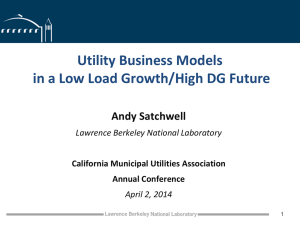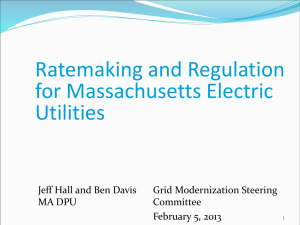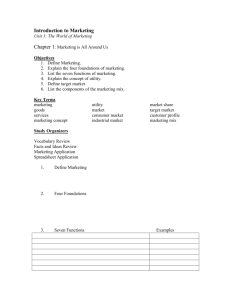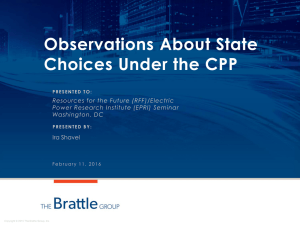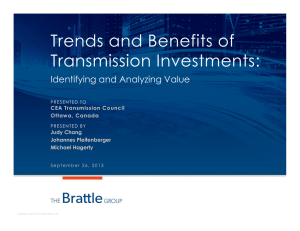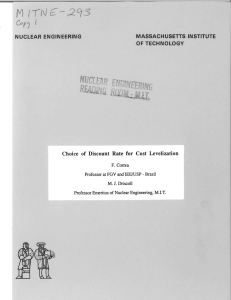Philip Hanser
advertisement
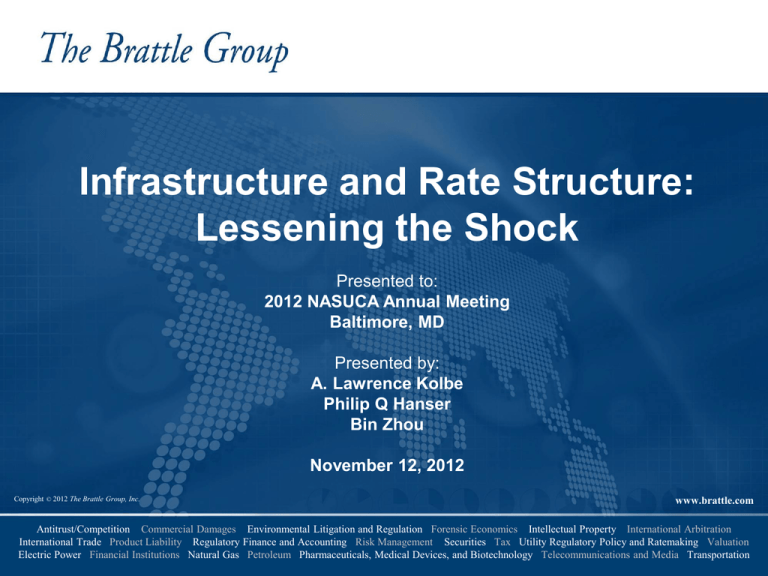
Infrastructure and Rate Structure: Lessening the Shock Presented to: 2012 NASUCA Annual Meeting Baltimore, MD Presented by: A. Lawrence Kolbe Philip Q Hanser Bin Zhou November 12, 2012 Copyright © 2012 The Brattle Group, Inc. www.brattle.com Antitrust/Competition Commercial Damages Environmental Litigation and Regulation Forensic Economics Intellectual Property International Arbitration International Trade Product Liability Regulatory Finance and Accounting Risk Management Securities Tax Utility Regulatory Policy and Ratemaking Valuation Electric Power Financial Institutions Natural Gas Petroleum Pharmaceuticals, Medical Devices, and Biotechnology Telecommunications and Media Transportation Challenges Facing Utilities and Ratepayers The utility industry’s infrastructure and environmental compliance investment needs are enormous. Forecast of Electricity Utility Investments Base Case: No Carbon Policy Upper Case: with Carbon Policy Capital Investment in $ Billions (2010 - 2030) Generation Transmission AMI and EE/DR* Distribution Total 505 298 85 582 1,470 951 298 192 582 2,023 * Advanced Metering Infrastructure, Energy Efficiency / Demand Response Programs Source: Brattle Report "Transforming America's Power Industry: The Investment Challenge 2010-2030," Table 1. 2 Slow Growth in Electricity Demand At the same time, electricity demand (and utility revenues) is expected to grow slowly: “U.S. Electricity Use Is Expected To Grow Slowly … electricity demand growth has slowed progressively by decade since 1950, from 9% per year in the 1950s to less than 2.5% per year in the 1990s. Electricity demand grows by 0.8% per year through 2035.” (EIA) The combination of investment requirements and slowed growth in electric demand can potentially lead to rate shocks. 3 A Unique Moment? Interest rates are at historic lows as is inflation in short-run. U.S. Treasury Rates and Inflation Rates in the Last 3 Decades 30.0% Inflation Rate 10-Year Treasury Rate 25.0% 20.0% 15.0% 10.0% 5.0% 0.0% 1980-01 1985-01 1990-01 1995-01 2000-01 2005-01 2010-01 Source: Federal Reserves (Treasury Rates) and Bureau of Labor Statistics (Inflation). Source: Federal Reserve Bank of Cleveland, “Estimates of Inflation Expectations.” These conditions make investing now very attractive. 4 Traditional Ratemaking Contributes to Rate Shocks Standard ratemaking based on depreciated original cost (OC) leads to front-end loaded rates. Rate Base and Capital Charges under Standard Ratemaking ($1,000 Asset, 20-Year Straight-line Depreciation, 9% Nominal Cost of Capital) Remaining Rate Base Annual Capital Charges 1,200 180 1,000 150 800 120 600 90 400 60 OC 200 OC 30 0 0 1 3 5 7 9 11 13 15 17 19 21 1 5 3 5 7 9 11 13 15 17 19 Alternative Ratemaking Can Reduce This Problem Rate Base and Capital Charge under Alternative Ratemaking Methodologies ($1,000 Asset, 20-Year Straight-line Depreciation, 9% Nominal and 7% Real Cost of Capital) Remaining Rate Base Annual Capital Charges 180 1,200 Levelized Rate 150 1,000 Levelized Rate 120 800 TOC 600 400 TOC 90 60 OC 200 OC 30 0 0 1 3 5 7 9 11 13 15 17 19 21 1 3 5 7 9 11 13 15 17 19 • Trended original cost (TOC): delays inflationary portion of the rate of return; • Level real rate (shown above): level total recovery in real terms (but rising in nominal); • Level nominal rate (not shown): level total recovery in nominal terms. In addition, these rates are more consistent with prices in competitive markets. 6 Levelized Rates Widely Used Outside Electric Utilities TOC or levelized (real or nominal) rates have been adopted in FERC-regulated industries: • TOC first adopted by FERC in the 1980s for oil pipelines, but just for equity; • Increasingly used in gas pipelines and electric transmission; • Many technical/implementation details have been resolved in FERC proceedings. Comparison of Capital Recovery Rate 12.0% Alliance Depreciation Rate 10.0% Kern River 25-year Straight Line 8.0% 6.0% 4.0% 2.0% 0.0% 1 2 3 4 5 6 7 8 9 10 11 12 13 14 15 Levelized rates are also widely used in independent power purchase contracts and renewable contracts. 7 Impact of Levelized Rates v. Other Mechanisms Allowing construction work in progress (CWIP) in the rate base offers short-term funding relief over the construction period, but could still lead to rate shocks: ♦ CWIP in rate base: the return on investment during construction is directly recovered in current rates rather than capitalized and deferred for future recovery; ♦ Pre-funding of construction costs serves similar purposes. Levelized rates can be used in combination with CWIP to further spread the capital cost recovery over the life of the asset’s service period. 8 Investor Risks and Utility Financing Challenges While alleviating rate shocks, levelized rates and TOC delay capital recovery. ♦ Investors will want compensation for the increases in risks. • Regulatory risk aside, investors require higher rates of return for longer-maturity investments. ♦ Utilities will view these approaches as raising their financing challenges and regulatory risk. • Multiple tranches of debt with different maturities may be required to match the project cash flows. • Utilities debt/equity ratio may have to be decreased. 9 Remedies for Investor Risks / Financing Challenges Mechanisms to reduce regulatory risks. ♦ Establish regulatory processes and procedures to measure capital recovery: • Reinvested Earnings Account (akin to regulatory asset accounts in accounting). ♦ Legislation may be needed that strengthens the commitment to long-term recovery of the capital investment. Credit rating agencies recognize explicitly the regulatory commitment in evaluating a utility’s credit worthiness. ♦ A positive feedback between regulatory environment and credit ratings may lower the cost of debt and, ultimately, rates. 10 Conclusions Huge investments for utility infrastructure and environmental compliance are needed. ♦ Financing costs are at record lows. ♦ Traditional ratemaking front-end loads investment costs, aggravating the problem of rate shock. Levelized and TOC rates can reduce the rate impacts. ♦ Widely adopted in other energy industries. ♦ Increased risk to investors and utilities must be addressed for these approaches to work. 11 Additional Readings Myers, S.C., A.L. Kolbe, and W.B. Tye, “Regulation and Capital Formation in the Oil Pipeline Industry,” Transportation Journal, Vol. 23, No. 4 (Summer, 1984), pp. 25-49. Myers, S.C., A.L. Kolbe, and W.B. Tye, “Inflation and Rate of Return Regulation,” Research in Transportation Regulation, Vol. 2 (1985), pp. 83-119. Tye, W.B., and A.L. Kolbe, “Optimal Time Structures for Regulated Industries,” Transportation Practitioners Journal, Vol.59, No. 2 (Winter, 1992), pp. 176-196. Graves, F., P.Q. Hanser, and G. Basheda, “Rate Shock Mitigation,” Edison Electric Institute, June 2007. Hanser, P.Q., M. Celebi, and B. Zhou, “State Regulatory Hurdles to Utility Environmental Compliance,” The Electricity Journal, April 2012. Kolbe, A.L., P.Q. Hanser, and B. Zhou, “Infrastructure and Rate Structure: Lessening the Shock,” The Brattle Group working paper (forthcoming). 12 Speaker Speaker Bio Bioand andContact ContactInformation Information Insert corporate headshot here. Philip Q Hanser Principal Cambridge, MA Phil@brattle.com Phone: (617) 864-7900 Fax: (617) 864-1576 Mr. Hanser assists clients in issues ranging from utility industry structure and market power and associated regulatory questions, to specific operational and strategic issues, such as transmission pricing, generation planning, and tariff strategies. He also has expertise in fuels procurement, environmental issues, forecasting, marketing and demand-side management, and other complex management and financial matters. Over his thirty years in the industry, Mr. Hanser has appeared as an expert witness before the Federal Energy Regulatory Commission (FERC), many U.S. and Canadian public utility and siting commissions, before arbitration panels, and in federal and state courts. He served six years on the American Statistical Association’s Advisory Committee to the Energy Information Administration (EIA). Prior to joining The Brattle Group, Mr. Hanser held teaching positions at the University of the Pacific, University of California at Davis, and Columbia University, and served as a guest lecturer at the Massachusetts Institute of Technology, Stanford University, and the University of Chicago. He is currently a Senior Associate, Mossavar-Rahmani Center for Business and Government, Harvard Kennedy School. He has also served as the manager of the Demand-Side Management Program at the Electric Power Research Institute (EPRI). He has been published widely in leading industry and economic journals. The views expressed in this presentation are strictly those of the presenter(s) and do not necessarily state or reflect the views of The Brattle Group, Inc. 13 Contact Us www.brattle.com North America Cambridge, MA +1.617.864.7900 Washington, DC +1.202.955.5050 San Francisco, CA +1.415.217.1000 London, England +44.20.7406.7900 Madrid, Spain +34.91.418.69.70 Rome, Italy +39.06.48.888.10 Europe 14



